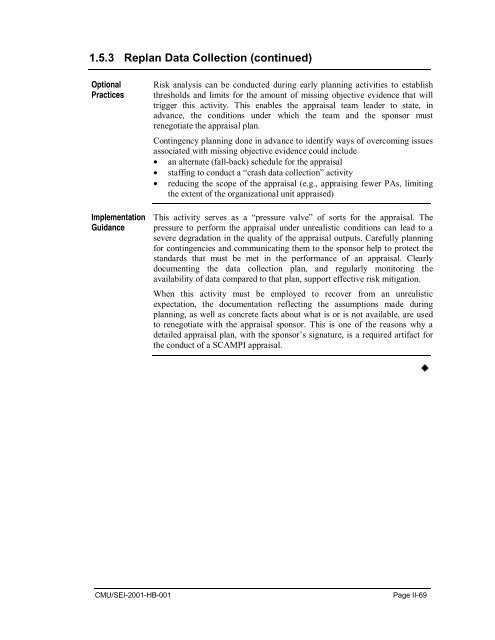Standard CMMI Appraisal Method for Process Improvement (SCAMPI)
Standard CMMI Appraisal Method for Process Improvement (SCAMPI)
Standard CMMI Appraisal Method for Process Improvement (SCAMPI)
Create successful ePaper yourself
Turn your PDF publications into a flip-book with our unique Google optimized e-Paper software.
1.5.3 Replan Data Collection (continued)<br />
Optional<br />
Practices<br />
Implementation<br />
Guidance<br />
Risk analysis can be conducted during early planning activities to establish<br />
thresholds and limits <strong>for</strong> the amount of missing objective evidence that will<br />
trigger this activity. This enables the appraisal team leader to state, in<br />
advance, the conditions under which the team and the sponsor must<br />
renegotiate the appraisal plan.<br />
Contingency planning done in advance to identify ways of overcoming issues<br />
associated with missing objective evidence could include<br />
• an alternate (fall-back) schedule <strong>for</strong> the appraisal<br />
• staffing to conduct a “crash data collection” activity<br />
• reducing the scope of the appraisal (e.g., appraising fewer PAs, limiting<br />
the extent of the organizational unit appraised)<br />
This activity serves as a “pressure valve” of sorts <strong>for</strong> the appraisal. The<br />
pressure to per<strong>for</strong>m the appraisal under unrealistic conditions can lead to a<br />
severe degradation in the quality of the appraisal outputs. Carefully planning<br />
<strong>for</strong> contingencies and communicating them to the sponsor help to protect the<br />
standards that must be met in the per<strong>for</strong>mance of an appraisal. Clearly<br />
documenting the data collection plan, and regularly monitoring the<br />
availability of data compared to that plan, support effective risk mitigation.<br />
When this activity must be employed to recover from an unrealistic<br />
expectation, the documentation reflecting the assumptions made during<br />
planning, as well as concrete facts about what is or is not available, are used<br />
to renegotiate with the appraisal sponsor. This is one of the reasons why a<br />
detailed appraisal plan, with the sponsor’s signature, is a required artifact <strong>for</strong><br />
the conduct of a <strong>SCAMPI</strong> appraisal.<br />
<br />
CMU/SEI-2001-HB-001<br />
Page II-69
















